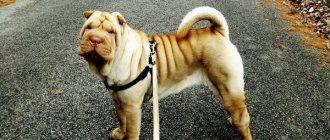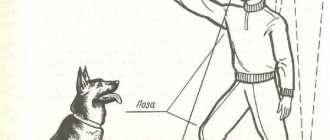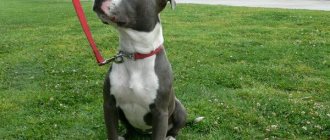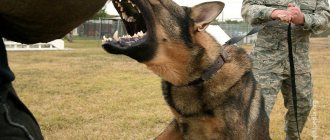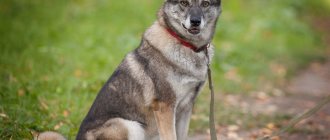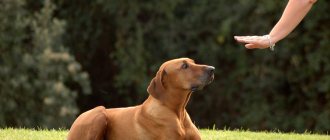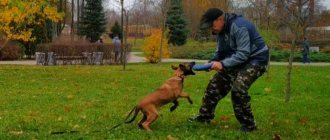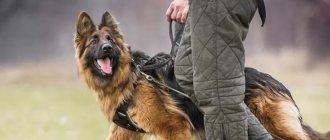Labrador as a breed developed towards the end of the 19th century, and as an independent phenotype it was officially recognized by the English Kennel Club in 1903.
A powerful, well-built dog with free movements and an active, sociable character.
Affectionate with children, an excellent gun hunting dog, with virtually no flaws.
Are they easy to train?
The Labrador Retriever is an intelligent and obedient dog, confident in its abilities.
Labradors are persistent in achieving their goals and always want to please their owner. These two qualities make the breed one of the most successfully trainable dogs. .
In Stanley Coren's rating, Labradors take 7th place out of 80 in their ability to understand a new command in less than 5 repetitions, leaving behind Rottweilers, spaniels, and schnauzers.
History of the breed
The Labrador breed originates from the east coast of Canada, on the island of Newfoundland. They were bred as working dogs.
Initially, they were used by fishermen to help pull out nets and fish. Therefore, such dogs are excellent swimmers.
Due to their excellent abilities, the retriever is used in many types of different “works”. These dogs help not only rescuers and police officers do their job, they are the only guide dogs for blind people.
Can it perform security functions and protect the owner?
Labradors are one of the most loyal dog breeds and truly love the family they live with..
They also love all other people indiscriminately and nothing can make them lose faith that life is wonderful and every person passing by wishes him and his owner well.
So never and under no circumstances will a Labrador become a guard.
It will not be able to protect the owner during an attack or in some other stressful situation . The maximum that can be expected from him in such unpleasant cases is a serious, powerful bark.
According to the breed standard, these dogs should not show aggression, and breeders, when breeding and further maintaining the breed, are very careful about this quality and at the slightest hint of aggressiveness, the individual is discarded, not allowing further breeding.
Dog handlers believe that if you start training a Labrador to guard the territory or try to teach it commands from a course on protective guard service, this will inevitably break the animal’s psyche and the dog will become hysterical, uncontrollable and uncontrollable, naturally without learning security skills.
Possible difficulties
It is recommended to start working with a dog from 2 months. In adulthood, during training, many owners encounter difficulties arising from the impulsiveness of the breed. Dogs are often distracted, try to escape from classes, and prefer games.
Labradors are able to outwit the owner by luring out treats. At the same time, dogs make ideal hunters, guides, and trackers. Dogs are also capable of guarding skills, but with difficulty.
Labradors are equally trainable at any age. Able to remember a command 2-5 times.
Sometimes puppies already perform complex tasks at 3 months of age.
At what age should training begin?
From approximately the age of 1.5 months, the second period of socialization of the dog begins, which is most suitable for education and initial training, which can be considered the initial stage of training.
Positive skills and catch reflexes are developed quickly and easily.
The nervous system reacts quickly to favorable and not very favorable influences from the outside. The general level of physical and emotional activity is high, so the puppy’s activity is dominated by an indicative-exploratory reaction.
IMPORTANT!
From the age of 1.5 months, you need to carefully but persistently give the dog signals about what is allowed to do and what is not.
Even from such a small age of the puppy, the owner must constantly observe the established rules and demand that the dog follow them: if it is impossible, then it is impossible for the rest of its life, without exceptions.
For example, if you do not plan to let a 35-pound dog into your bed in the future, then this should be taboo for a one-and-a-half-month-old puppy; If you don’t want a dirty dog the size of a small calf, happy to meet you, to enthusiastically jump on your face, then you shouldn’t allow the puppy to do this either.
Education from an early age at home is the basis for strengthening the relationship between owner and dog.
Carrot or stick - which method to choose
A rhetorical question. Just 10-15 years ago, all dog handlers spoke in unison about “dominance” and that a dog must respect its owner. Today, the situation has changed dramatically; an increasing number of animal psychologists are confident that you need to raise a dog through positivity.
Properly selected motivation makes the dog carry out commands with joy, which even looks more impressive. When a pet is raised without the use of a “whip”, he is absolutely confident in himself and has unlimited trust in his owner. By replacing the “carrot” with cruelty, there is a high chance of getting a frightened, nervous creature that, at any opportunity, tries to escape from its owner.
Where to start training and how long you need to train
A puppy is like a small child: it needs care, affectionate but demanding education and love. From the moment a puppy appears in the house, its upbringing and training must begin with accustoming it to a name and to being handled.
It is necessary to help the puppy to be in the company of people and other pets, not to be afraid of noisy or sharp sounds, to accustom him to order and daily routine..
Already at this age, when the puppy does not yet go outside, you should begin to accustom him to wearing a collar and a leash attached to it: the owner’s task is to convey to the baby that this is not scary.
At this stage, training will not take much time: 5-10 minutes a day for each skill, while constantly confirming the need for the behavioral reactions expected from the dog with your confident, calm behavior, and the puppy will be prepared for further, more serious training.
Do not tighten the collar too tightly (2 fingers should fit under it freely) or too loosely.
Expert opinion
Kozhevin Semyon Kirillovich
Expert dog handler.
You can train, for example, using one technique as a basis. Its essence lies in the fact that in each period of a dog’s growing up and life, one dominant motive of behavior stands out, most clearly expressed at a given stage of life, which is used as a motivator during training. A choleric Labrador will actively and joyfully work for the opportunity to play with a toy and run for a frisbee; an obvious food eater will follow commands for a special treat. That is, the reward for a correctly executed command can be anything, from your favorite crackers to games and affection.
Keeping a Labrador Retriever - necessary conditions
Keeping a Labrador does not require outdoor conditions; it cannot live in an enclosure or on a chain.
Accommodation is only possible in an apartment, private house or country residence. Not suitable for life with restricted movement and living in street conditions. For a comfortable stay together, from the first days of the puppy’s arrival, it is necessary to create appropriate conditions. This is not difficult, follow the recommendations and the result will meet your expectations.
Before your baby arrives, prepare:
- A warm and soft bed where he will sleep;
- Choose a place to eat, preferably the kitchen;
- Buy toys with squeakers and regular “no sound” toys, balls of different sizes;
- Food bowls;
- Bowl stand or wall mount;
- Feed;
- Combing brushes and slicker brush;
- Shampoo, lotion for animal care (ears, eyes);
- Nail clipper for cutting nails;
- Treats and dental bones;
- Disposable diapers;
- Collar and leash, harness;
- Parasite repellents: fleas, ticks and anthelmintics;
- Cover and cover for a sofa, bed, car.
Types of reflexes
A reflex—the nervous system’s response to stimulation—can be conditioned or unconditioned.
Unconditioned reflexes, given by nature, constant and unchanging reactions of the body, include:
- unconditioned reflexes of a newborn puppy (sucking, swallowing, crawling), helping him adapt to the world around him;
- more complex unconditioned reflexes (food, orientation, movement, search, games, sexual, parental).
Unconditioned reflexes serve as the basis for practicing conditioned reflexes, which are so necessary for training dogs..
They, in turn, are divided into natural (formed only in response to the natural qualities of the stimulus) and artificial (those formed as a result of extraneous stimuli).
The reaction to the voice and appearance of the owner is a natural conditioned reflex; it is formed naturally, without effort and does not fade for a long time.
The reaction to the sound of a command, a gesture, a whistle is an artificial conditioned reflex that is slowly formed and without constant training and proper reinforcement quickly fades away.
Dog training is based precisely on the varied use of artificial conditioned reflexes.
We take proper care
In addition to all the commands and training of the golden retriever, it also needs to be properly cared for.
When taking a puppy into your home, be sure to get all the necessary injections for various diseases.
Your dog should always have clean, filtered water ! The puppy should be fed on time and bathed regularly.
You need to be very careful when choosing a collar. It should not be very small, otherwise it may injure your neck. This needs to be constantly monitored, as the dog grows quite quickly.
Also, during care, you should remember about castration/sterilization of your pet. It is important to understand why the dog was bred and whether there is a desire to have offspring. Other issues should be carefully considered.
How to toilet train and diaper at home
As a rule, the puppy urinates immediately after sleep/play/15 minutes after eating, and before cleansing the intestines, it worries for some time, looking for a comfortable place, sometimes whining.
Having noticed that the puppy is preparing to recover, you need to quickly draw his attention to yourself with some exclamation.
The pet will react, its urges will subside for a while, and there will be an opportunity to put a diaper on it. In this case, you definitely need to be patient and wait for the correction!
Over time, he will develop the necessary reflex, and when he needs to go to the toilet, he will do it in a diaper without outside help .
Good teacher
Even though Labradors are dogs, different types of human morality are still very easily applied to them. The character of your pet will absolutely depend on its owner.
You can wean a dog using different methods, but it will be more effective to encourage your pet rather than anger at it.
Dog handlers advise weaning your dog from doing “bad” things by enticing them away. It consists of switching the dog's attention from one thing to another.
For example, in order to wean your pet from biting, you need to transfer his attention from his hands to a toy or stick.
In this way, the moment of training will be playful and the dog itself will wean itself from bad habits.
How to stop jumping on people
The need to jump, as a kind of greeting ritual, is formed from puppyhood. The purpose of such jumps is to get food. That is why the puppy strives to get to the face of the owner (or another person): he jumps instinctively, just as he bites.
In such situations, some advise stopping the dog with a knee strike and squeezing its front paws. You shouldn't do this. There are much more humane and no less effective methods.
You can, together with the command “No!” or “You can’t!” extend your palm towards the animal and step forward towards it or encourage alternative behavior .
NOTE!
You need to start weaning off jumping on people from puppyhood. If the Labrador is already an adult and has not been taught to restrain his emotions, experienced dog breeders advise wearing a halter and practicing self-control.
It is possible that the Labrador, as an extremely active and cheerful dog, will need quite a lot of time for this.
Experts advise practicing endurance on many, many people, in various situations, rewarding with treats for not jumping, then the desired behavior pattern will form and the dog will stop jumping..
If the dog is on a leash and is about to jump on someone, you need to sharply pull the leash.
Primary puppy socialization
Once a little Labrador arrives in a new apartment, it will take time to get used to the environment. Gradually accustom him to a place to sleep and a place to eat. When sending to the place, give the appropriate command.
Demarcate the territory; a bed and a place for eating are different places. Disposable diapers are placed much further from the sleeping area.
You will need to train your puppy to:
- New nickname, call him by name as often as possible;
- Wearing a collar and walking on a leash (start with a short time, put on the collar and leash before
- every time you go outside, at home, all the equipment is removed);
- At first, carry it in your arms; the puppy should not go down the stairs on his own;
- Go outside at least 3-4 times, preferably immediately after sleeping and feeding;
- Accustom to new sounds: TV, car noise, crowded places;
- Loud sounds: thunder, rain, thunderstorm, fireworks, screaming children, music;
- Visit crowded places as often as possible;
- Change routes;
- Take it with you to the store.
After 2 weeks or 5-7 days, start your first lessons on learning commands. The simplest ones are taken, on their basis all training in the future will be built:
- It is forbidden;
- Sit;
- Place;
- Wait;
- Ugh;
- Lie;
- Voice.
If you are planning to take your Labrador hunting, read our article about the peculiarities of upbringing in advance. As soon as you have learned the first commands, move on to more complex ones, increasing the time of training; more about the nuances of training below.
How to stop pulling on a leash
Most often, the reason that a Labrador pulls on the leash is the incorrect behavior of the owner, who does not understand the psychology of the animal.
When a dog pulls on the leash, it means that it is in control of the situation, not the owner, and it becomes unclear who is walking whom.
To solve this problem you need to follow the following rules:
- keep the leash loose from the very beginning;
- when moving, periodically follow the dog and at times force it to turn in the direction you want, using a treat, toy or target;
- while moving, try to constantly maintain contact with the dog with your voice, gestures, and rewards for correct behavior;
- whenever the Labrador begins to pull on the leash, stop or walk back (the dog needs to understand that as soon as it pulls on the leash, the movement towards the goal stops, it is useless to resist).
Naturally, these rules are easier to apply when the Labrador is still small . Therefore, raising a dog, including weaning it off from pulling, must begin at an early age.
You should not solve the problem of a tight leash by putting on a strict collar or, especially, a shock collar ! Labrador is not a breed that requires such extreme measures.
Features of the first days of life
The puppy must get used to the new place; it will require time and initial socialization. The owner needs to prepare the house and household for proper behavior.
What you need from the owner:
- Remove all small objects that the puppy can reach and eat;
- Breakable items, glass, small parts or objects;
- Wires and extension cords;
- Shoes and things;
- Lift everything that the puppy can reach to the top;
- Carpets and carpet are removed or covered for the first time;
- Cover the place where the baby eats with oilcloth - on the floor and wall;
- Remove cat litter boxes (he will dig around there and may eat poop or litter);
- Place powders, cleaning products and other chemicals out of reach.
Imagine that you have a small child who does not walk and puts everything in his mouth, all the steps in preparing the apartment are similar.
Before you start caring for your Labrador, make sure that you have all of the above, be mentally prepared for puddles on the floor, piles in the corner and pranks.
How to teach basic commands
With the help of basic commands, the owner can control the animal everywhere - at home, on the street, in the country, on a trip.
If you don’t set grandiose goals for yourself, just a few basic commands are enough to properly raise a Labrador:
- Dog handlers say: if the dog does not follow the command “Come to me!”, consider that you do not have a dog . This command is given in a loud voice in a commanding tone, the gesture is standing facing the dog at some distance (hands pressed to the hips), raising the hand to the side to shoulder level with the palm down, and then sharply lowering it to the thigh (maybe with a light slap on the leg) . The dog must approach/run up to the owner, go around him from behind and sit at his left leg, then the command is considered completed. If the command is carried out correctly, the Labrador receives a treat.
- The command “Sit!” is given by a gesture - raising a hand or finger . At the beginning of training, the command is supplemented with a voice; later, only a gesture is used, which the Labrador should easily distinguish from other gestures. Alternatively, you can hold the treat with your thumb and middle finger, while pointing your index finger upward - this will become a gesture indicating a request for a seat. Upon completion of the correct execution of the command - a treat.
- To practice the command “Lie down!” — you need to say this command and lower your hand, previously raised to shoulder level, with your palm down (towards the dog). Correctly executed command: the dog immediately assumes a prone position (torso to the ground, front and hind legs parallel to the body).
- To teach your Labrador the prohibitive command “Fu!” (“No!”) - you need to use a strictly defined technique: first a prohibition (command), and then punishment of the animal in case of non-compliance (a strong jerk with the leash, throwing an object at the dog or in the immediate vicinity of it, for example, a rattler) ). The prohibiting command must be given precisely at the moment when the dog is ready to begin performing an undesirable action. There is no need to reward the animal for doing it.
Team "Ugh!" especially important for Labradors . They are called “vacuum cleaners”: many dogs of this breed, not accustomed to the prohibitive command “Ugh!”, retain the habit throughout their lives of picking up everything they encounter on the way and instantly eating it. The life and health of a Labrador depends on knowledge of this command.
- The command “Stop!” is no less important for a dog’s life. : with its help you can stop even a running dog in emergency situations; it will be needed when examining the pet, cleaning, putting on equipment. It is given by voice and gesture (standing facing the dog, sharply raising the hand forward with the palm up to the shoulder).
- Team "Voice!" - is given verbally with a simultaneous presentation of a gesture (waving the right hand, bent at the elbow, at shoulder level, palm forward) or snapping the fingers of the hand raised above the dog. When teaching this command, the dog must sit and be hungry. As soon as he barks, he needs to be praised and given a treat.
Worthy of a treat
The very first command that the puppy must remember is “Place”. As soon as he crosses the threshold of the house and gets acquainted with the territory, you must immediately show him this place. It doesn’t matter whether it’s a bed in an apartment or an enclosure with a booth in the yard.
In the process of exploring new possessions, he himself will wander where he needs to go. Then, with a slight movement of your hand, hold it there for a while. At the same time, say the command: “Place” several times. In the future, these steps will need to be repeated several times a day.
If a new family member accidentally enters the prohibited territory, you need to take him to the place and repeat the command. Labradors are very intelligent. In just a few days, your dog will know that it is possible to go here and not to go there. Very soon he will learn to go “to himself” on his own on command.
Every correctly performed action needs to be reinforced with a treat. The puppy should have positive feelings associated with this command. Then he will love his own corner and will not lie around anywhere. If the Labrador were human, he would probably think: “I’m lying in my place and worthy of praise and treats.”
But not everything can always go smoothly. Be sure to be patient, do not get irritated or yell, and, moreover, never hit your pet. Such treatment can negate all your further efforts. Remember that a Labrador is a dog that is trying to understand what is required of it.
Training scheme
The earlier training is started, the more successful the results of training will be.
The main thing is not to subjugate the animal through intimidation, physical punishment, or pressure, but to establish strong friendly relations with it, based on mutual trust and understanding..
That is why, before the Labrador is six months old, you need to have time to train your pet to carry out basic commands, although the obedience will not yet be clear and impeccable, but the dog will be familiar with the basic norms of behavior.
The earliest age at which a dog finds itself in its new home is 1.5-2 months. From this time it is worth starting the process of education.
Below is an approximate scheme for raising and training a Labrador:
| Puppy age | What needs to be taught |
| 2 months |
|
| 3 months |
|
| 4 months |
|
| 5 months |
|
| 6 months |
|
| from 7 months to 1 year |
|
If you stick to this schedule, by the end of the first year of life, the Labrador will become a well-mannered dog.
If the puppy cannot get used to cleanliness after 6 months, subject to proper toilet training, you need to work with your veterinarian to look for problems in the pet’s psyche or physiology.
What you need for proper care
Before you bring a Labrador puppy into your home, stock up on everything you need to properly care for him. In the list below we have tried to collect everything that you will need to take care of:
Dishes for food and water - it is not necessary to buy two bowls; one will be enough for a Labrador puppy. He eats quite quickly - after the bowl is empty, you can pour clean water into it for drinking. The dishes should be enameled metal or stainless steel - if you do not want them to scrape on the floor when the dog eats, choose dishes with a rubber bottom.
One bowl is enough for a Labrador, they eat very quickly, after which you can immediately pour water
- Dog food – for at least 1 month it should be exactly the same as what the baby was fed by the breeder. Later, you can begin to gradually switch him to a different type of diet - but do not do it too abruptly, so as not to create a stressful situation.
- Toys should be special toys for dogs; children's toys are not suitable. Choose sizes based on the size of your pet, while avoiding buying squeakers and anything else that may cause concern. A cast ball, duck or rope is best - these options will work best. At the same time, do not buy a lot of things at once - at first one or two toys will be enough. After 1 month, give your pet something new, and after 2 months, something else.
- Bed - it can be made of wood, plastic or woven from fibers. In the apartment, this is the place where your pet will sleep, relax, or simply follow the “Place!” command. You shouldn’t worry: “My puppy is chewing on the bed!” - let him chew it better than shoes or baseboards. At the same time, immediately select the sizes for an adult dog - puppies grow very quickly, and before you know it, your pet will no longer fit on the toddler bed.
Labrador puppies grow very quickly, so don't buy too many things for the baby.
- Leash with collar – choose textile as a material, which is softer than other options and allows you to adjust the length. Calculate the length of the leash so that you can let the dog go 2.5 meters. We recommend choosing a tarpaulin - it is soft and will not cause injury to your palm. If you decide to buy a tape measure, wait until your Labrador puppy grows up, since the tape measure is convenient for a mature, well-mannered dog.
- A first aid kit, a nail clipper, combs, shampoo - all this can be bought a little later.
Basic mistakes when training
Many inexperienced owners make mistakes when training. The result of this is, at best, bad manners of the pet; with gross mistakes in upbringing, the animal’s psyche can suffer.
So, when training a Labrador, like any other dog, you should not:
- conduct the first classes in places with a large number of distracting stimuli - the animal will react to them, and the trainer’s actions will remain unnoticed;
- often use strong painful stimuli or physical punishment to reinforce the prohibiting command - the dog will begin to fear both the trainer and the command;
- use a prohibiting command and not back it up with influence or use it inappropriately - the Labrador will stop responding to it;
- encourage the pet until the command is fully completed;
- each time pronounce the dog’s name before giving the command “Come to me!” - the dog will get used to following the command only after it hears its name;
- every time after executing the command “Come to me!” fasten the dog on a leash and go home - the pet will begin to respond to the call as a signal to stop walking and will stop obeying;
- give the command “Near!” without backing it up with a jerk - you may not get a reaction to the command;
- give a command too loudly;
- act rudely towards a student.
Labrador is a breed that is highly trainable, and the owner of the dog can easily handle raising it himself, but it happens that for some reason the owner is unable or does not have time to understand the behavioral characteristics of dogs.
In this case, it is better to trust professionals in order to get the desired result and not harm your pet..
Tips from dog handlers
According to experienced dog handlers, Labradors are food eaters, so they learn lessons much better and faster if they receive something tasty as a reward. But you have to be careful; this breed is very smart and quick-witted; the dog can be capricious on purpose, carry out commands at full strength in order to eat as much treat as possible. You should not follow your pet’s lead; it is important to be persistent, demanding and unwavering.
You should contact professional dog handlers after your pet is eight months old. A specialist will be able to cope with even the most disobedient Labrador; commands will be carried out on demand. But in most cases, owners train their pets on their own.
Retriever bathing
Labradors are water lovers . They are famous as lifesavers at sea. Therefore, be prepared to catch your dog swimming or lying in a puddle when walking with it without a leash. If there is a pond with clean water near the walking areas, then let the dog out for a swim . If the animal has bathed in mud, then it is washed from head to toe with a special shampoo. If the animal avoids puddles, then bathing is carried out once every 4 to 6 months.
Advice! Wash your dog's paws and belly after every walk. Brush the dog every day or every other day.
Photo gallery
Everyone already knows the expression “A dog is man’s best friend!” And if we are talking about a breed like a Labrador, photographs of which you can see below, then this is absolutely true.
Don't scare passersby
An important part of training is the dog's calm attitude towards the muzzle. Despite the fact that the Labrador is absolutely peaceful, he must be tolerant of this item in his wardrobe. After all, the Labrador Retriever has quite large dimensions and with its appearance can scare not only a child, but also an adult. Therefore, it is important to teach him to wear a muzzle while walking.
This precaution is needed not so much for himself, but for the people around him. Not all of them behave adequately towards other people's animals. Someone may start to run away in panic, another may wave their arms and scream. And although the Labrador is a very kind dog, no one can predict exactly how he will react to these actions.
Well, and finally, there are government regulations that oblige the owner to walk a dog in a muzzle in public places. Violation is punishable by an administrative fine. Its size is established by local legal documents adopted in each individual locality in Russia.
